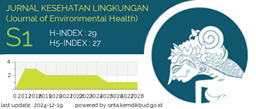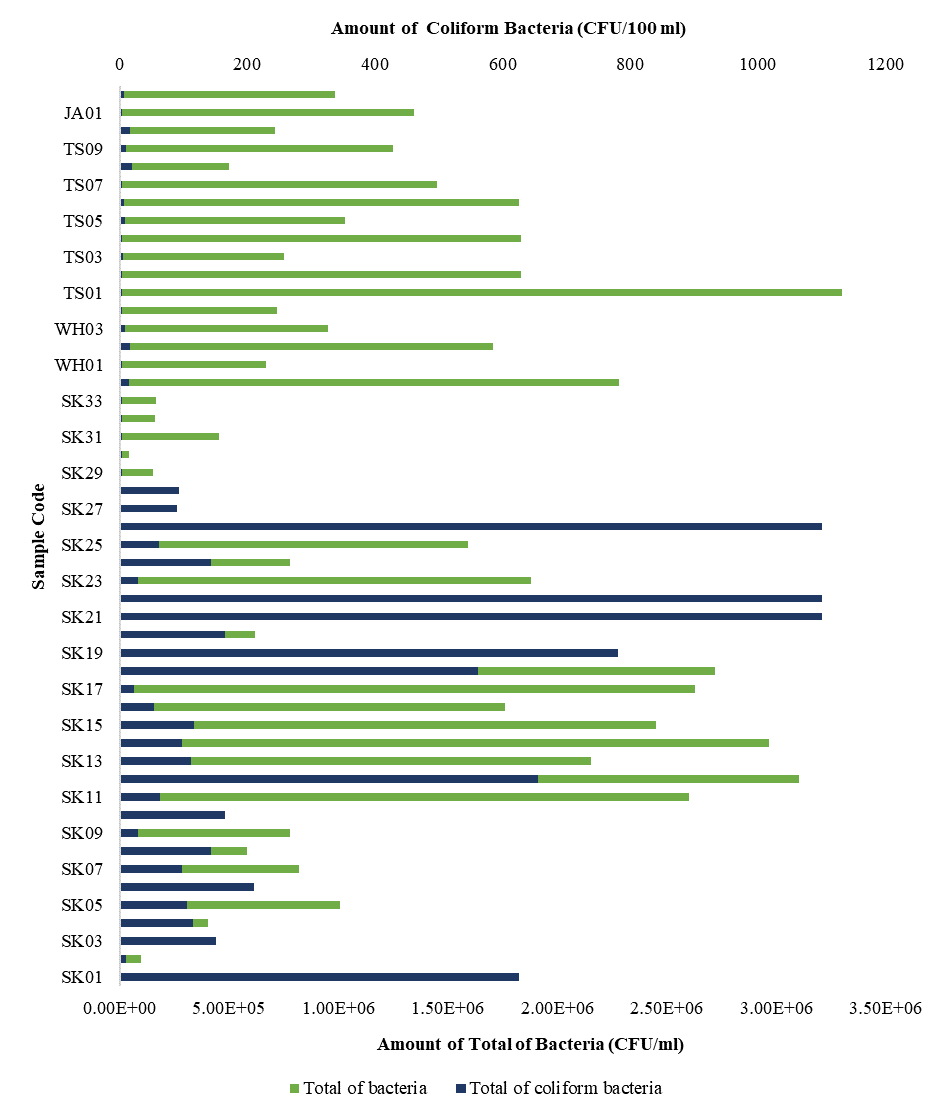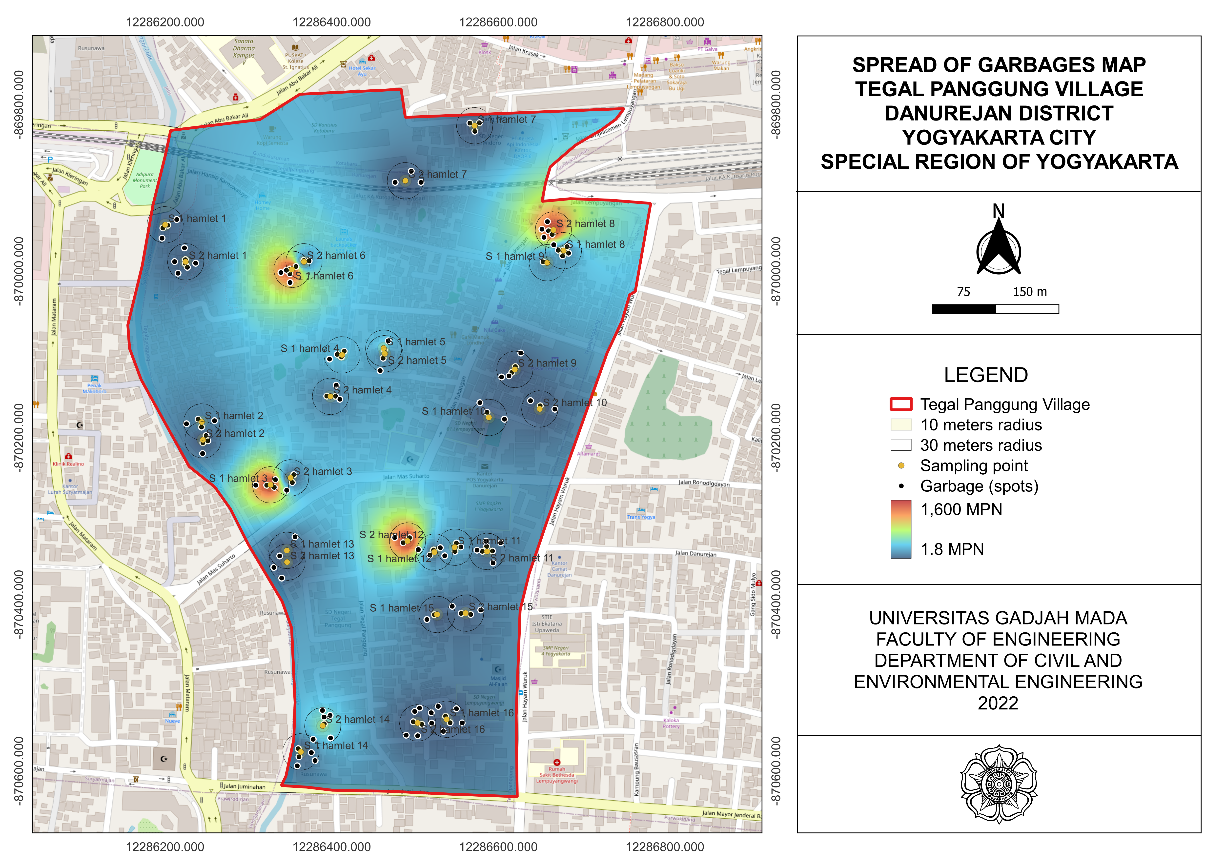Drinking Water Quality of Water Refill Station in Gebang Raya Tanggerang

Introduction: As a drinking water provider, refill drinking water station must comply with hygiene and sanitation standards for water quality, including the microbiological value standard for clean water. This study was conducted to determine the microbial levels in refill drinking water station and analyze the drinking water quality based on sanitation hygiene observations. Methods: The study included laboratory test methods, cross-sectional analysis tests, and a descriptive analysis. Drinking water sampling and sanitation observations were performed using the total sampling technique on 17 water station. As much as 100 ml of drinking water samples were taken directly from the faucet to refill water with a sterile bottle container. Sanitary hygiene was studied through interviews using an observation sheet. Results and Discussion: The most bacteria were found at 108 per 100ml in Escherichia coli parameters and 866 per 100ml in coliform parameters in the station water samples with the Station 8 (SK) code. The interviews showed that seven station did not meet the criteria for good sanitation hygiene. Conclusion: Sanitary hygiene is carried out to reduce or eliminate bacterial contamination in drinking water. Observations and laboratory tests show that good sanitation is related to drinking water quality.
Arlinda S, Suksmerri S, Mukhlis M. Risk Analysis of Community Water Quality in Alahan Panjang Agricultural Area, Solok Regency, West Sumatera, Indonesia. J Kesehat Lingkung. 2022;14(3):193–200. https://doi.org/10.20473/jkl.v14i3.2022.193-200
Iryanto AA, Firmansyah YW, Wahyu Widyantoro AZ. Spatial Patterns Of Environmental Sanitation Factors As Determinants of Toddlers Diarrhea in Pauh District, Padang CIty in 2021. J Kesehat Lingkung. 2022;14(2):71–81. https://doi.org/10.20473/jkl.v14i2.2022.71-81
Oktaviani T. Hygiene and Sanitation of Refill water Depo at PT X, Taman, Sidoarjo. J Kesehat Lingkung. 2018;10(4):376–384. https://doi.org/10.20473/jkl.v10i4.2018.376-384
Nurhayati L, Utami WS, Jauhani MA, Armiyanti Y, Hermansyah B. Physical Water Quality Contaminated By Soil-Transmitted Helminths in Sumbersari District, Jember Regency. J Kesehat Lingkung. 2022;14(4):282–288. https://doi.org/10.20473/jkl.v14i4.2022.282-288
Indasah I. Effect of Good Hygiene Sanitation and Personal Hygiene Stasion Management of Refill Water on the Quality of Drinking Water Reviewed from Most-Probable-Number Coliform in Kediri. Fol Med Indones. 2018;54(4):241-248. https://doi.org/10.20473/fmi.v54i4.10705
Central Beureu Statistic of Republic Indonesia. Statistic of Clean Water 2015 – 2020. Jakarta: Central Beureu Statistic of Republic Indonesia; 2020. https://www.bps.go.id/publication/2021/12/16/a641ca7512995e9d254ee194/statistik-air-bersih-2015-2020
Sumolang OD, Maddusa SS, Umboh JML. Gambaran Hygiene Sanitasi dan Kandungan Mikrobiologi pada Stasion Air Minum (DAM) di Wilayah Kerja Puskesmas Kolongan Kecamatan Kalawat Kabupaten Minahasa Utara. J Kesehat Masy Univ Sam Ratulangi. 2020;9(4):34–40. https://ejournal.unsrat.ac.id/index.php/kesmas/article/view/29407
Ummah M. Hygiene and Sanitation of Drinking Water Stasion and Microbiology Quality of Drinking Water in Ngasem Primary Healthcare Area, Kediri, East Java. J Kesehat Lingkung. 2019;11(4):286-292. https://doi.org/10.20473/jkl.v11i4.2019.286-292
Marhamah A, Santoto B. Refill Water Quality at Drinking Water Stasion in South Manokwari Regency. Cassowary. 2020;3(1):61–71. https://doi.org/10.30862/casssowary.cs.v3.i1.39
Wyasena PNT, Sudaryati NLG, Sudiartawan IM, Adnyana IMD. Evaluation of Refillable Drinnking Water Quality Based on MPN Coliform and Escheria Coli in Sesetan Village, South Denpasar Bali. J Vocat Heal Stud. 2022;6(2):93–101. https://doi.org/10.20473/jvhs.V6.I2.2022.93-101
Trisna Y. Water Quality and Public Health Complaints in Surrounding Watoetoelis Sugar Mills. J Kesehat Lingkung. 2018;10(2):241–251. https://doi.org/10.20473/jkl.v10i2.2018.241-251
Novitasari D. Processing System and Evaluation Microbiological Quality of Drinking Water Fountain in Surabaya City. J Kesehat Lingkung. 2020;12(3):154–162. https://doi.org/10.20473/jkl.v12i3.2020.154-162
Rohmawati Y, Kustomo. Analisis Kualitas Air pada Reservoir PDAM Kota Semarang Menggunakan Uji Parameter Fisika, Kimia, dan Mikrobiologi, serta Dikombinasikan dengan Analisis Kemometri. Walisongo J Chem. 2020;3(2):100–107. https://doi.org/10.21580/wjc.v3i2.6603
Ravsanjanie MM, Pawitra AS, Diyanah KC, Zakaria ZA, Marmaya NHB. Utilization of Clean Water, Personal Hygiene of Toddler Caregivers, and Smoking Behavior of Family Members as Risk Factors for Cases of Stunting Toddlers. J Kesehat Lingkung. 2021;13(1):48-56. https://doi.org/10.20473/jkl.v13i1.2021.48-56
Raksanagara A. Aspek Internal dan Eksternal Kualitas Produksi Stasion Air Minum Isi Ulang: Studi Kualitatif di Kota Bandung. Majalah Kedokteran Bandung. 2018;50(1):53–60. https://doi.org/10.15395/mkb.v50n1.1143
Putra CMM. The Physical and Microbiological Quality of Clean Water In Nanas Sub Village Kediri District Post Natural Phenomena Sinking Wells. J Kesehat Lingkung. 2018;10(4):360–367. https://doi.org/10.20473/jkl.v10i4.2018.36-367
Putri A. Identifkasi Keberadaan Bakteri Coliform dan Total Mikroba Dalam Es Dung Dung di Sekitar Kampus Universitas Muhamadiyah Surakarta. J Media Gizi Indones. 2018;13(1):41-48. https://doi.org/10.20473/mgi.v13i1.41-48
Arumsari F, Joko T, Darundiati YH. Hubungan Higiene Sanitasi Stasion Air Minum dengan Keberadaan Bakteri Escherichia Coli pada Air Minum Isi Ulang di Kecamatan Mondokan Kabupaten Sragen. Media Kesehat Masy Indones. 2021;20(2):75–80. https://doi.org/10.14710/mkmi.20.2.75-82
Ministry of Health Republic of Indonesia. Regulation of Ministry of Health Republic Indonesia No. 492/MENKES/2010 about Quality Requirements of Drinking Water. Jakarta: Ministry of Health Republic of Indonesia; 2010
Zarifah DA. Hygiene Sanitasi Stasion Air Minum Isi Ulang dan Kualitas Mikrobiologis Air Minum Isi Ulang di Wilayah Kerja Puskesmas Bukitsangkal Kota Palembang. J Sanitasi Lingkung. 2022;2(2):92-99. https://jurnal.poltekkespalembang.ac.id/index.php/SJKL/article/view/1304/868
Celesta AG. Overview Basic Sanitation In Payaman Village, Bojonegoro District 2016. J Kesehat Lingkung. 2019;11(2):83–90. https://doi.org/10.20473/jkl.v11i2.2019.83-90
Yuasadam NZ. Sanitation and Personal Hygiene on Canteen Dharma Wanita Persatuan Airlangga University. J Kesehat Lingkung. 2018;10(2):175–180. https://doi.org/10.20473/jkl.v10i2.2018.175-180
Hasrianti. Analisis Warna, Suhu, pH, dan Salinitas Air Sumur BOR di Kota Palopo. Prosiding Seminar Nasional. 2016;2(1):747–896. https://journal.uncp.ac.id/index.php/proceding/article/view/520
Konstantin T. The Correlation Between Water, Sanitation, and Hygiene With Soil-Transmitted Helminths Infection among Elementary School Children of Aru Islands District, Maluku. Indones J Public Heal. 2021;16(2):273–284. https://doi.org/10.20473/ijph.v16i2.2021.273-284
Assegaf F. Uji Kandungan Bakteriologi Air Minum Isi Ulang pada Stasion Air Minum isi Ulang (DAMIU) di Desa Wayame Kecamatan Teluk Ambon Kota Ambon. Glob Heal Sci. 2018;3(4):318–321. http://dx.doi.org/10.33846/ghs.v3i4.298

This work is licensed under a Creative Commons Attribution-NonCommercial-ShareAlike 4.0 International License.
1. Copyright of all journal manuscripts is held by the Jurnal Kesehatan Lingkungan.2. Formal legal provisions to access digital articles of electronic journal are subject to the provision of the Creative Commons Attribution-ShareAlike license (CC BY-NC-SA), which means that Jurnal Kesehatan Lingkungan is rightful to keep, transfer media/format, manage in the form of databases, maintain, and publish articles.
3. Published manuscripts both printed and electronic are open access for educational, research, and library purposes. Additionally, the editorial board is not responsible for any violations of copyright law.
JKESLING by UNAIR is licensed under a Creative Commons Attribution-ShareAlike 4.0 International License.







































